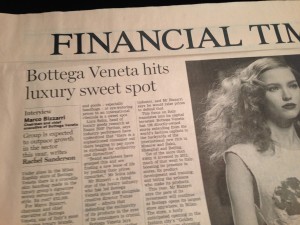Author Archives: Julian Stubbs
Place Branding: July 4th, 2013. And I am in Amsterdam I am.
- Monday, 08 July 2013 09:48
- Written by Julian Stubbs
- 0 Comments
July 4th, as we all know, is a rather special day. And for me its special for a couple of good reasons. Firstly its the day our colonial cousins mistakenly threw off the rule of mad King George and us British. It was an obvious mistake by the yanks as since then they have never managed to win anything at cricket and their football team, or soccer as they call it, is absolutely rubbish. Just think what they might have achieved. I write this knowing full well that a few of my American friends will respond with outrage at these remarks and want to correct my lack of appreciation and understanding of their own culture and what they call sports (these are generally activities that no one else in the world wants to play, so that they can declare themselves world champions).
Place Branding. Copenhagen is losing out to Stockholm. And now they have another problem…
- Monday, 03 June 2013 08:21
- Written by Julian Stubbs
- 0 Comments
Copenhagen is losing out to Stockholm when it comes to inward investment.
Between 2006 and 2009 Copenhagen attracted just seven global companies, whilst Stockholm attracted 23. This article, Fighting for the Lead in Øresund Magazine, admits Copenhagen has been losing the battle for investment as companies flock north to Stockholm. I believe some fundamental mistakes were made in the approach and process used in developing the brand positioning, selection of the wrong brand (Øresund – where’s that etc?) and also the wrong positioning. The Øresund brand, developed by Wally Olins at considerable cost, has now been dumped, but will Copenhagen / Malmö region be able to develop a strong new brand and strategy?
And now Copenhagen has a new problem – Oslo. The city is getting itself geared up to stake-out its own positioning and Oslo Gardermoen airport is rapidly catching Copenhagen Kastrup as Scandinavia’s number one airport in passenger numbers- and we all know companies put accessibility at the top of their wish list when it comes to selection of places as potential locations.
Seems like things are getting interesting.
Source: Statistics Øresund Magazine.
Place Branding: Liverpool. City on the UP
- Thursday, 23 May 2013 14:16
- Written by Julian Stubbs
- 0 Comments
Im lucky enough to be visiting one of my favourite cities in the world – Liverpool. I’m here meeting some of the people behind the branding of the city and carrying out some research for my next book on Place and Destination branding.
Now, not only do I love the local football team, but I also love this Victorian port city built on the banks of the river Mersey. It was once the commercial gateway for the British Empire, home of The Beatles, two cathedrals and a famous football team (or two depending on your point of view).
 However, in the last seventy or so years, Liverpool has seen difficult times. Being heavily bombed in the second world war and then devastated by recession during the 1970s, has made it a city with true grit. The city has refocused itself in recent years, making significant investments in a massive urban renewal programme. In 2008 the city was rewarded by being named European Capital of Culture. Walk the streets of the city and you realise Liverpool still has a way to go but it is now heading in a confident new direction.
Liverpool is part of a wider region called Merseyside and according to Liverpool Vision, the organisation behind the Liverpool 2008 brand, there has always been confusion when talking to external and international audiences about Merseyside. Liverpool Vision recognised the strength they had in the city of Liverpool and developed it as an attack brand to help market the whole region. Liverpool did not have its own strong brand identity up to that point. However being Capital of Culture gave it an opportunity to create a new brand for that year. There was a need to ensure that the positive work the region had started, was then continued after the year as Capital of Culture, so new branding work was required.
Stakeholder driven
The city saw stakeholder involvement as a key part of their work. Liverpool already had an influential group called Liverpool First a group of important stakeholders consisting of major businesses, governmental organisations, public sector agencies, as well as representatives from voluntary and community groups. These groups all worked together to discuss important issues about the area. It was Liverpool First who commissioned Liverpool Vision to develop the new brand. Therefore stakeholder engagement was already achieved.
Leveraging the citys strength
Research established that the city had an impressive number of icons to leverage in developing the citys new brand identity. As well as worldwide strengths associated with The Beatles and football, Liverpool is recognised as a city on the up.
Extensive regeneration projects combined with warm welcoming people and a unique waterfront, helps it to stand out over other northern UK cities and destinations. A new brand logotype was developed along with launch events and a new web site, all of which were supported by a media campaign and extensive PR work that encouraged local businesses to use the new brand image in their own advertising.
Its still early days for the Liverpool brand, but the city has already seen success in companies working with their new identity and downloading it from their website. The question is now what comes next. Brands are about more than just logotypes and Liverpool has to re-asses its role not just in a northern UK cities context, or even a UK one, but more importantly as a world class city.
I believe Liverpool is a city on the UP, and I think it’s best days are yet to come.
Check out the Liverpool brand at:
www.itsliverpool.com
This blog is mostly reproduced from Wish You Were Here the first book on Place and Destination branding by Julian Stubbs. Wish You Were Here Too will be out in Spring 2014.
However, in the last seventy or so years, Liverpool has seen difficult times. Being heavily bombed in the second world war and then devastated by recession during the 1970s, has made it a city with true grit. The city has refocused itself in recent years, making significant investments in a massive urban renewal programme. In 2008 the city was rewarded by being named European Capital of Culture. Walk the streets of the city and you realise Liverpool still has a way to go but it is now heading in a confident new direction.
Liverpool is part of a wider region called Merseyside and according to Liverpool Vision, the organisation behind the Liverpool 2008 brand, there has always been confusion when talking to external and international audiences about Merseyside. Liverpool Vision recognised the strength they had in the city of Liverpool and developed it as an attack brand to help market the whole region. Liverpool did not have its own strong brand identity up to that point. However being Capital of Culture gave it an opportunity to create a new brand for that year. There was a need to ensure that the positive work the region had started, was then continued after the year as Capital of Culture, so new branding work was required.
Stakeholder driven
The city saw stakeholder involvement as a key part of their work. Liverpool already had an influential group called Liverpool First a group of important stakeholders consisting of major businesses, governmental organisations, public sector agencies, as well as representatives from voluntary and community groups. These groups all worked together to discuss important issues about the area. It was Liverpool First who commissioned Liverpool Vision to develop the new brand. Therefore stakeholder engagement was already achieved.
Leveraging the citys strength
Research established that the city had an impressive number of icons to leverage in developing the citys new brand identity. As well as worldwide strengths associated with The Beatles and football, Liverpool is recognised as a city on the up.
Extensive regeneration projects combined with warm welcoming people and a unique waterfront, helps it to stand out over other northern UK cities and destinations. A new brand logotype was developed along with launch events and a new web site, all of which were supported by a media campaign and extensive PR work that encouraged local businesses to use the new brand image in their own advertising.
Its still early days for the Liverpool brand, but the city has already seen success in companies working with their new identity and downloading it from their website. The question is now what comes next. Brands are about more than just logotypes and Liverpool has to re-asses its role not just in a northern UK cities context, or even a UK one, but more importantly as a world class city.
I believe Liverpool is a city on the UP, and I think it’s best days are yet to come.
Check out the Liverpool brand at:
www.itsliverpool.com
This blog is mostly reproduced from Wish You Were Here the first book on Place and Destination branding by Julian Stubbs. Wish You Were Here Too will be out in Spring 2014.
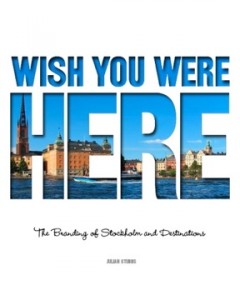 Wish You Were Here on Amazon:
http://www.amazon.com/Wish-You-Were-Here-Destinations/dp/1456414232/ref=sr_1_1?ie=UTF8&qid=1370060366&sr=8-1&keywords=julian+stubbs
Wish You Were Here on Amazon:
http://www.amazon.com/Wish-You-Were-Here-Destinations/dp/1456414232/ref=sr_1_1?ie=UTF8&qid=1370060366&sr=8-1&keywords=julian+stubbs
 However, in the last seventy or so years, Liverpool has seen difficult times. Being heavily bombed in the second world war and then devastated by recession during the 1970s, has made it a city with true grit. The city has refocused itself in recent years, making significant investments in a massive urban renewal programme. In 2008 the city was rewarded by being named European Capital of Culture. Walk the streets of the city and you realise Liverpool still has a way to go but it is now heading in a confident new direction.
Liverpool is part of a wider region called Merseyside and according to Liverpool Vision, the organisation behind the Liverpool 2008 brand, there has always been confusion when talking to external and international audiences about Merseyside. Liverpool Vision recognised the strength they had in the city of Liverpool and developed it as an attack brand to help market the whole region. Liverpool did not have its own strong brand identity up to that point. However being Capital of Culture gave it an opportunity to create a new brand for that year. There was a need to ensure that the positive work the region had started, was then continued after the year as Capital of Culture, so new branding work was required.
Stakeholder driven
The city saw stakeholder involvement as a key part of their work. Liverpool already had an influential group called Liverpool First a group of important stakeholders consisting of major businesses, governmental organisations, public sector agencies, as well as representatives from voluntary and community groups. These groups all worked together to discuss important issues about the area. It was Liverpool First who commissioned Liverpool Vision to develop the new brand. Therefore stakeholder engagement was already achieved.
Leveraging the citys strength
Research established that the city had an impressive number of icons to leverage in developing the citys new brand identity. As well as worldwide strengths associated with The Beatles and football, Liverpool is recognised as a city on the up.
Extensive regeneration projects combined with warm welcoming people and a unique waterfront, helps it to stand out over other northern UK cities and destinations. A new brand logotype was developed along with launch events and a new web site, all of which were supported by a media campaign and extensive PR work that encouraged local businesses to use the new brand image in their own advertising.
Its still early days for the Liverpool brand, but the city has already seen success in companies working with their new identity and downloading it from their website. The question is now what comes next. Brands are about more than just logotypes and Liverpool has to re-asses its role not just in a northern UK cities context, or even a UK one, but more importantly as a world class city.
I believe Liverpool is a city on the UP, and I think it’s best days are yet to come.
Check out the Liverpool brand at:
www.itsliverpool.com
This blog is mostly reproduced from Wish You Were Here the first book on Place and Destination branding by Julian Stubbs. Wish You Were Here Too will be out in Spring 2014.
However, in the last seventy or so years, Liverpool has seen difficult times. Being heavily bombed in the second world war and then devastated by recession during the 1970s, has made it a city with true grit. The city has refocused itself in recent years, making significant investments in a massive urban renewal programme. In 2008 the city was rewarded by being named European Capital of Culture. Walk the streets of the city and you realise Liverpool still has a way to go but it is now heading in a confident new direction.
Liverpool is part of a wider region called Merseyside and according to Liverpool Vision, the organisation behind the Liverpool 2008 brand, there has always been confusion when talking to external and international audiences about Merseyside. Liverpool Vision recognised the strength they had in the city of Liverpool and developed it as an attack brand to help market the whole region. Liverpool did not have its own strong brand identity up to that point. However being Capital of Culture gave it an opportunity to create a new brand for that year. There was a need to ensure that the positive work the region had started, was then continued after the year as Capital of Culture, so new branding work was required.
Stakeholder driven
The city saw stakeholder involvement as a key part of their work. Liverpool already had an influential group called Liverpool First a group of important stakeholders consisting of major businesses, governmental organisations, public sector agencies, as well as representatives from voluntary and community groups. These groups all worked together to discuss important issues about the area. It was Liverpool First who commissioned Liverpool Vision to develop the new brand. Therefore stakeholder engagement was already achieved.
Leveraging the citys strength
Research established that the city had an impressive number of icons to leverage in developing the citys new brand identity. As well as worldwide strengths associated with The Beatles and football, Liverpool is recognised as a city on the up.
Extensive regeneration projects combined with warm welcoming people and a unique waterfront, helps it to stand out over other northern UK cities and destinations. A new brand logotype was developed along with launch events and a new web site, all of which were supported by a media campaign and extensive PR work that encouraged local businesses to use the new brand image in their own advertising.
Its still early days for the Liverpool brand, but the city has already seen success in companies working with their new identity and downloading it from their website. The question is now what comes next. Brands are about more than just logotypes and Liverpool has to re-asses its role not just in a northern UK cities context, or even a UK one, but more importantly as a world class city.
I believe Liverpool is a city on the UP, and I think it’s best days are yet to come.
Check out the Liverpool brand at:
www.itsliverpool.com
This blog is mostly reproduced from Wish You Were Here the first book on Place and Destination branding by Julian Stubbs. Wish You Were Here Too will be out in Spring 2014.
 Wish You Were Here on Amazon:
http://www.amazon.com/Wish-You-Were-Here-Destinations/dp/1456414232/ref=sr_1_1?ie=UTF8&qid=1370060366&sr=8-1&keywords=julian+stubbs
Wish You Were Here on Amazon:
http://www.amazon.com/Wish-You-Were-Here-Destinations/dp/1456414232/ref=sr_1_1?ie=UTF8&qid=1370060366&sr=8-1&keywords=julian+stubbs
Place Branding. Place Matters.
- Tuesday, 09 April 2013 14:24
- Written by Julian Stubbs
- 0 Comments
My mother, who is 86, slammed the phone down yesterday on her well known UK bank after being transferred to some foreign call centre. Was it because my Mother doesn’t like foreigners? Well actually no not at all. She objected to her bank, which positions itself as English, not living up to what it promises. Being English. Doubtless the bank in question would say it has to do with lower costs, improved service blah blah blah. Rubbish. It’s just penny pinching and losing sight of what their brand is all about.
Over the years I remember sitting in a few meetings, with heads of marketing, communication and even senior managers, where they proclaim – almost proudly – that ‘Where we are located doesn’t matter. We want to be seen as global‘.
What a load of tosh. The fact is where you come from often makes you what you are. More importantly it can provide a real differentiator when it comes to positioning and actually saying something authentic about yourselves. Pity a few more senior execs in anonymous global conglomerates didn’t understand that. They often talk about being different, and then deny one of the most important elements that helps makes them so.
I read in this mornings FT that Bottega Veneta, the maker of posh handbags, had seen revenues rise by a third and were making more money than ever. CEO Marco Bizzarri said ‘For us Made in Italy is so important.’ He continues ‘We’ve found that as long as our quality is maintained the customers are willing to pay a premium.’ Just a fluke? Take a look at the automobile sector, where having a premium brand with the German engineering stamp on it adds value and customer loyalty.
Be proud of where you come from. Place matters.
Place Branding: Speech at MIPIM
- Tuesday, 12 March 2013 08:53
- Written by Julian Stubbs
- 0 Comments
In Cannes for MIPIM the world’s leading real estate development event. Giving a speech here today at the Palais des festivals, on the Branding of Cities. Will be on the Oslo stand, with Oslos governing Mayor Stian Berger Røsland, talking about the work we are doing at UP with the city’s branding process.
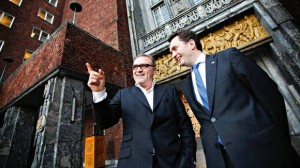 Oslo is a fascinating city with very much its own pulse. It’s a place going through rapid change and it’s now examining its identity. Like all places it needs to find its own positioning and that is what we’ve been asked to look at. It’s not about slogans – it’s about developing a long term strategy and process that builds a strong positioning.
We’re obviously delighted to be asked to be involved in this project and I think the extent of the media coverage we’ve been given in the national newspaper Aftenposten as well as on radio, shows the strength of the interest locally.
Oslo is a fascinating city with very much its own pulse. It’s a place going through rapid change and it’s now examining its identity. Like all places it needs to find its own positioning and that is what we’ve been asked to look at. It’s not about slogans – it’s about developing a long term strategy and process that builds a strong positioning.
We’re obviously delighted to be asked to be involved in this project and I think the extent of the media coverage we’ve been given in the national newspaper Aftenposten as well as on radio, shows the strength of the interest locally.
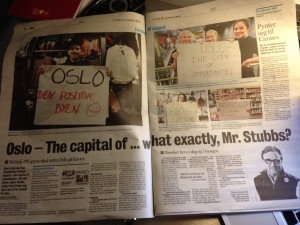
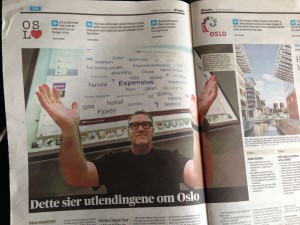 UP FOR REAL is the new Place Branding focused organisation within UP THERE, EVERYWHERE.
UP FOR REAL is the new Place Branding focused organisation within UP THERE, EVERYWHERE.

 Oslo is a fascinating city with very much its own pulse. It’s a place going through rapid change and it’s now examining its identity. Like all places it needs to find its own positioning and that is what we’ve been asked to look at. It’s not about slogans – it’s about developing a long term strategy and process that builds a strong positioning.
We’re obviously delighted to be asked to be involved in this project and I think the extent of the media coverage we’ve been given in the national newspaper Aftenposten as well as on radio, shows the strength of the interest locally.
Oslo is a fascinating city with very much its own pulse. It’s a place going through rapid change and it’s now examining its identity. Like all places it needs to find its own positioning and that is what we’ve been asked to look at. It’s not about slogans – it’s about developing a long term strategy and process that builds a strong positioning.
We’re obviously delighted to be asked to be involved in this project and I think the extent of the media coverage we’ve been given in the national newspaper Aftenposten as well as on radio, shows the strength of the interest locally.

 UP FOR REAL is the new Place Branding focused organisation within UP THERE, EVERYWHERE.
UP FOR REAL is the new Place Branding focused organisation within UP THERE, EVERYWHERE.

